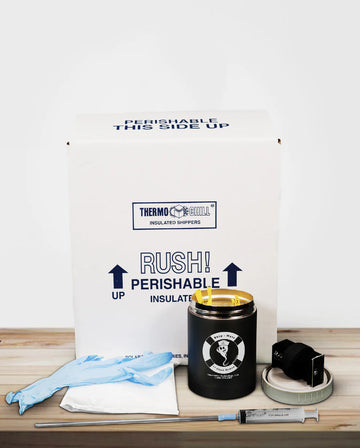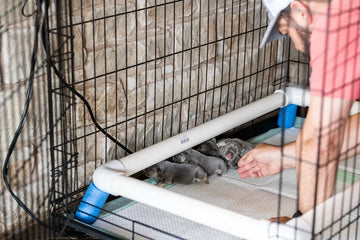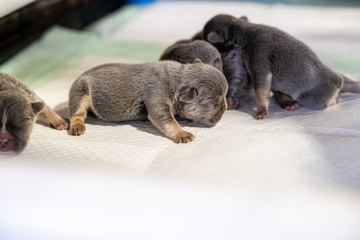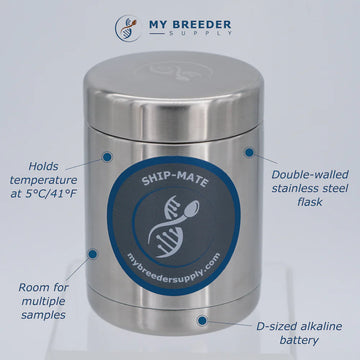Parvo Test for Dog Breeders – What You Need to Know
by Phenyx Media on Apr 03, 2023
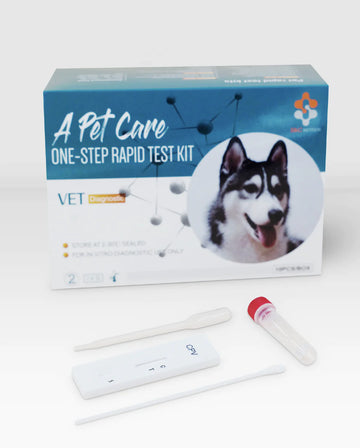
Introduction to Parvovirus

Canine parvovirus (CPV) is a highly contagious and potentially deadly viral infection that affects dogs, particularly puppies. This virus primarily targets the gastrointestinal system, causing severe damage to the lining of the intestines. In some cases, it can also affect the heart and lead to long-term cardiac problems.
Symptoms of Parvovirus
Some common symptoms of parvovirus include:
- Lethargy
- Vomiting
- Diarrhea (often bloody)
- Loss of appetite
- Dehydration
- Fever
If you notice any of these signs in your dogs, it's crucial to seek veterinary care immediately.
Importance of Parvo Testing for Dog Breeders
For dog breeders, early detection and prevention of parvovirus are essential. Identifying infected dogs and taking the necessary precautions can prevent the virus from spreading throughout your breeding facility, ensuring the health and safety of your dogs and future litters.
The Parvo Test
Types of Parvo Tests
There are two primary methods for testing for canine parvovirus: the polymerase chain reaction (PCR) test and the enzyme-linked immunosorbent assay (ELISA).
PCR Test
The PCR test is a molecular diagnostic test that detects the presence of the virus's genetic material in a dog's fecal sample. This test is highly accurate and can detect the virus even in its early stages. However, PCR testing is generally more expensive and requires a longer turnaround time than ELISA testing.
Enzyme-Linked Immunosorbent Assay (ELISA)
The ELISA test is an antigen detection test that identifies the presence of the virus in a dog's feces. This test is rapid, cost-effective, and can be performed in a veterinarian's office or at home using a commercially available test kit. While the ELISA test is sensitive, it may produce false negatives in some cases, particularly if the dog is in the early stages of infection.
When to Test for Parvo
Puppies

Puppies are at the highest risk for parvovirus infection due to their developing immune systems. It is recommended to test puppies before they receive their first vaccination and before introducing them to other dogs or environments where the virus may be present.
Pregnant Dogs
Parvovirus can be transmitted to unborn puppies if the mother is infected during pregnancy. Testing pregnant dogs for parvovirus is essential to ensure the health of both the mother and her litter.
New Dogs
Before introducing a new dog into your breeding facility, it is crucial to test them for parvovirus to prevent potential spread to other dogs.
How to Prevent Parvovirus Infection
Vaccination
Vaccination is the most effective way to protect your dogs against parvovirus. Puppies should receive their first vaccine between 6 to 8 weeks of age, followed by a series of booster shots every 3 to 4 weeks until they are 16 to 20 weeks old. Adult dogs should receive booster vaccinations according to their veterinarian's recommendations. Remember to keep vaccination records for all dogs in your breeding facility.
Proper Hygiene
Maintaining a clean environment is essential in preventing the spread of parvovirus. Regularly disinfect your breeding facility, paying particular attention to areas where dogs eat, sleep, and eliminate. Use a bleach solution or other parvocidal disinfectants to clean surfaces, food and water bowls, toys, and bedding. Encourage proper hygiene among staff and visitors by providing handwashing stations and shoe covers.
Quarantine and Isolation
Isolate any dog that shows symptoms of parvovirus or tests positive for the virus. Quarantine the affected dog in a separate area away from other dogs to prevent the spread of the virus. Regularly monitor the health of all dogs and promptly address any signs of illness.
Parvo testing is an essential tool for dog breeders to ensure the health and well-being of their dogs and litters. By understanding the different types of parvo tests, when to test, and how to prevent parvovirus infection, breeders can minimize the risk of this dangerous virus spreading throughout their facility. Regular testing, vaccination, proper hygiene, and quarantine measures are critical steps in maintaining a healthy breeding environment.
Supporting Your Dog During Parvo Treatment

Hospitalization and Supportive Care
Most dogs diagnosed with parvovirus will require hospitalization and intensive supportive care. This care may include intravenous fluid therapy to combat dehydration, electrolyte replacement, and medications to control vomiting and diarrhea. In some cases, blood transfusions may be necessary to treat severe anemia caused by blood loss due to intestinal bleeding.
Home Care and Monitoring
If your dog is stable enough to receive treatment at home, your veterinarian may provide you with specific instructions for supportive care. This may include administering oral rehydration solutions, medications to manage symptoms, and feeding a bland diet designed to be gentle on the digestive system. Monitor your dog closely for any signs of worsening condition, and contact your veterinarian immediately if you notice any changes.
Follow-Up Care
After your dog recovers from parvovirus, it is essential to schedule follow-up appointments with your veterinarian to monitor their progress and ensure no long-term effects are present. Gradually reintroduce your dog to their regular diet and activities, and pay close attention to any signs of recurring illness.
The Role of Nutrition in Parvo Recovery
Proper nutrition is crucial for a dog's recovery from parvovirus. A bland, easily digestible diet is recommended during the initial stages of recovery, as the dog's gastrointestinal system may still be sensitive.
High-Quality Protein Sources
Dogs recovering from parvovirus need high-quality protein sources to help repair damaged tissue and support the immune system. Good protein sources include boiled chicken, lean ground turkey, and fish.
Easily Digestible Carbohydrates
Provide easily digestible carbohydrates, such as cooked white rice or sweet potatoes, to supply your dog with energy during the recovery process.
Probiotics
Introducing probiotics into your dog's diet can help restore the balance of gut bacteria and support the digestive system. Consult your veterinarian for recommendations on appropriate probiotic supplements for your dog.
The Cost of Parvo Treatment

The cost of parvo treatment can vary widely depending on factors such as the severity of the infection, the duration of hospitalization, and the specific treatments required. Treatment costs can range from several hundred to several thousand dollars. Pet insurance policies may cover some or all of these costs, depending on the policy.
Financial Assistance for Parvo Treatment
If you are struggling to afford the cost of parvo treatment for your dog, several organizations provide financial assistance for pet owners in need. These organizations may offer grants, loans, or payment plans to help cover the cost of veterinary care. Consult with your veterinarian for recommendations on financial assistance programs that may be available in your area.
Parvovirus in Shelters and Rescue Organizations
Parvovirus can be particularly challenging for animal shelters and rescue organizations due to the high concentration of dogs and the potential for rapid spread of the virus. To protect the health of dogs in their care, shelters, and rescues should implement strict protocols for vaccination, hygiene, and quarantine.
Vaccination and Preventative Care
Ensure that all dogs in a shelter or rescue organization receive appropriate vaccinations, including parvovirus. Administer booster shots according to the recommended schedule to maintain immunity.
Hygiene and Disinfection
Maintain a rigorous cleaning schedule for all areas of the facility, using parvocidal disinfectants to eliminate the virus from surfaces, bedding, and equipment. Provide staff and volunteers with proper protective gear and training in hygiene practices to reduce the risk of spreading the virus.
Quarantine and Isolation Protocols
Implement quarantine and isolation protocols for newly admitted dogs, as well as any dogs showing signs of illness. This will help to minimize the spread of parvovirus and other contagious diseases within the facility. Monitor the health of all dogs closely and promptly address any signs of illness.
Adoption Screening and Education
When adopting out dogs from a shelter or rescue organization, screen potential adopters to ensure they are aware of the risk of parvovirus and the importance of proper vaccination and preventative care. Provide educational resources on parvovirus prevention and encourage adopters to establish a relationship with a veterinarian for ongoing care.
The Emotional Impact of Parvovirus on Dog Breeders, Owners, and Caregivers
Parvovirus can be an emotionally challenging experience for dog breeders, owners, and caregivers. The sudden onset and severity of the illness, combined with the potential for high mortality rates, can cause significant distress and feelings of guilt or helplessness.
Support for Breeders and Owners
If you are a dog breeder or owner struggling with the emotional impact of parvovirus, consider reaching out to support networks such as online forums, social media groups, or local breed clubs. Connecting with others who have experienced similar challenges can provide comfort and valuable advice for coping with the emotional aspects of dealing with parvovirus.
Self-Care and Compassion
It is essential to practice self-care and compassion during difficult times. Recognize that you are doing your best to care for your dogs and prevent the spread of the virus. Seek support from friends, family, or mental health professionals if needed, and remember that it is normal to feel a range of emotions during challenging experiences.
Educating Others
One positive way to cope with the emotional impact of parvovirus is to help educate others about the disease and its prevention. Sharing your experience and knowledge can contribute to a broader understanding of the importance of vaccination and preventative care, potentially helping to reduce the incidence of parvovirus in the future.
The Future of Parvo Prevention and Treatment
As veterinary medicine continues to advance, new strategies for preventing and treating parvovirus are likely to emerge. Ongoing research into improved vaccination protocols, antiviral medications, and novel therapies may lead to more effective ways to protect dogs from this devastating illness.
Emerging Therapies
Some experimental treatments, such as monoclonal antibody therapy, are being investigated for their potential to treat or prevent parvovirus infection. While these therapies are not yet widely available, they represent promising avenues for future research and development.
Improved Vaccination Strategies
Ongoing research into canine immunology may lead to the development of more effective vaccines or improved vaccination schedules, providing even better protection against parvovirus and other infectious diseases.
By staying informed about the latest advancements in parvovirus prevention and treatment, dog breeders, owners, and caregivers can play a vital role in safeguarding the health and well-being of their beloved pets.
FAQs About Parvo Testsing
1. How long does it take for a dog to show symptoms of parvovirus after exposure?
The incubation period for parvovirus is typically 3 to 7 days. However, symptoms may appear as early as 2 days or as late as 14 days after exposure.
2. Can adult dogs get parvovirus?
Yes, adult dogs can contract parvovirus, although they generally have a lower risk than puppies due to their more robust immune systems. Vaccination and proper hygiene practices can help protect adult dogs from infection.
3. How long does the parvovirus survive in the environment?
Parvovirus is highly resilient and can survive in the environment for months or even years under certain conditions. Regular cleaning and disinfection are crucial to reducing the risk of infection.
4. Can parvovirus be transmitted between different species?
While canine parvovirus is specific to dogs, some strains can infect other animals such as cats, raccoons, and foxes. However, these cases are relatively rare.
5. Are there any long-term effects of parvovirus in dogs that have recovered?
In most cases, dogs that recover from parvovirus can go on to lead healthy lives. However, some dogs may experience long-term damage to their gastrointestinal system or heart, depending on the severity of the infection. Regular veterinary check-ups can help monitor and manage any potential long-term effects.


